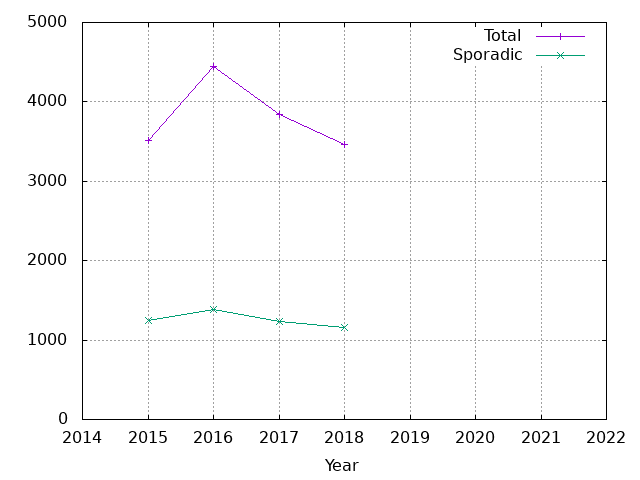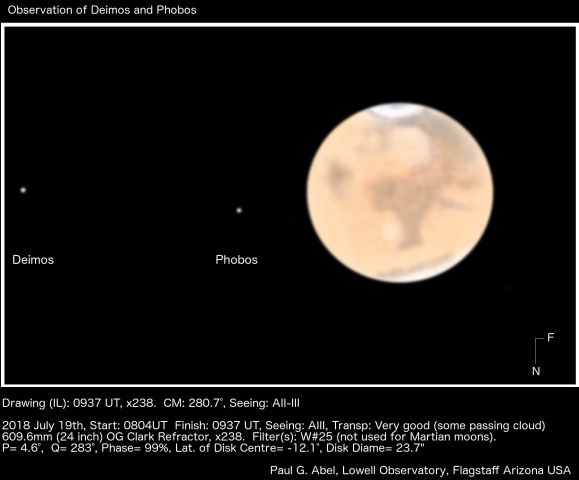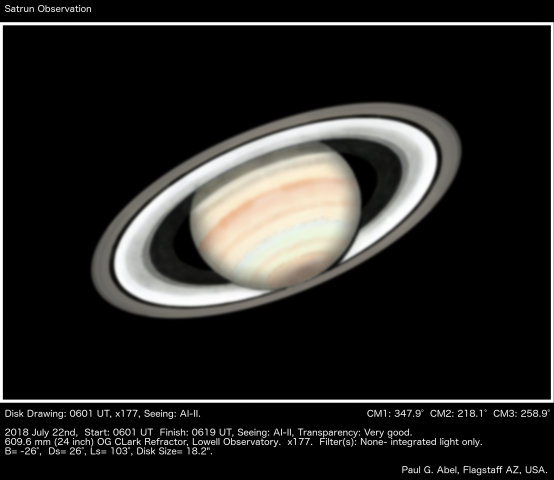› Forums › General Discussion › 2018 – how was it for you?
- This topic has 10 replies, 11 voices, and was last updated 6 years, 11 months ago by
John Cook.
-
AuthorPosts
-
1 January 2019 at 12:23 am #574222
 Jeremy ShearsParticipant
Jeremy ShearsParticipantWith 2018 having drawn to a close, I have been reviewing my 2018 observing stats.
During the year, I observed at home on 101 nights. This is 28% of all nights. As in previous years, I recorded the number of nights that I have actually observed – this could have been for a few minutes between clouds, or perhaps a whole night. Others were missed due to holidays, work travel etc (actually, the holidays allowed many additional nights of observing that are not counted in my stats!).
This is a significant improvement on 2017 (86 nights; 24%), but is still way below my average for 2005-2018 of 114.6 .nights (31.4%).
My best month in 2018 was October (15 nights), followed by Jan and May (13 nights). The worst was March with 3 nights (which was frustrating as March is normally pretty good).
I made CCD measurements of the brightness of 4594 variable stars.
My two automated video cameras captured 3209 meteors.
So how was 2018 for you?
Best wishes to everyone for 2019 with many clear skies!
Jeremy
1 January 2019 at 9:49 am #580446 Gary PoynerParticipant
Gary PoynerParticipantHappy New year Jeremy, and to all BAA members reading this.
A far better year than 2017 – which wasn’t too difficult to achieve.(2016 in brackets)North Birmingham.Clear nights (less than 50% cloud) 44 (25), Partially clear nights (50% or more cloud) 69 (61)Total observable nights 113 (86) with 55 of these nights being under Moonlight conditions. I made variable star observations on 108 of these 113 nights. This is my best year for clear nights since 2003.Total hours at the telescope: 237.3 (183.6)Best month May (March) 6 clear and 12 partially clearWorst month March (February) 2 clear and 2 partially clearOn 53 nights of the year, Birmingham Met Office gave the wrong prediction for cloud cover. This is a six night improvement on 2017. My weather owl did much better!My total visual VS observations for 2018 is 9,013 – the best year since 2009. It was a poor year for remote CCD observations though with only 1,767 observations obtained. This was due to the Open University COAST telescope being out of commission for most of the year, and a prolonged Monsoon in the SW USA which affected the AAVSOnet SRO-50 reflector in Arizona. All CCD observations were of variable stars – of course.2018 was memorable for me as I passed my 300,000th visual VS observation in October.Gary1 January 2019 at 9:54 am #580447 Nick JamesParticipant
Nick JamesParticipantHNY everyone!
The closest thing I have to an objective measurement of night-sky conditions in Chelmsford through the year is a plot of the total number of sporadic meteors detected by my two cameras here. This shows much less variation than the total number of meteors since that is biased by the conditions at the time of the major shower peaks. On this criterion 2018 was slightly worse than previous years but the variation is not significant.
 1 January 2019 at 11:15 am #580448
1 January 2019 at 11:15 am #580448 David BoydParticipant
David BoydParticipantDuring 2018 I was able to obtain photometry and/or spectroscopy on 111 nights out of 261 when I was at home and available to observe. Assuming this proportion was representative of the whole year, this suggests observations would potentially have been possible on 42.5% of nights during the year (in South Oxfordshire). This is very close to my average over the past 14 years (42.1%) so for me 2018 was a very average year. The best months were May (61.5%) and August (60.0%), the worst March (22.7%) and December (21.7%). My records show 14,890 photometry measurements and 2,663 spectra recorded during the year. Although not nearly as noteworthy as Gary’s visual observation record, I see my photometry measurements passed the 400,000 mark during the year.
Best wishes for clear(er) skies during 2019.
David
1 January 2019 at 4:16 pm #580451 Peter CarsonParticipant
Peter CarsonParticipantMy records show I made 281 comet observations of 50 different comets over 72 nights. My worst month was March and the best was August. 72 nights is a lot less than 2017 when I was out on 118 nights.
A clear morning followed by a clear night on the same day counts as one clear night, whereas a clear spell in the evening that spans midnight I count as two clear nights. During last year I changed my observing habit to avoid observing until after midnight because of my neighbours’ nuisance lights that generally go out after they go to bed. This change has probably reduced the number of nights I record as being clear.
I also reported 821 comet astrometric positions to the MPC during 2018.All the best for 2019
Peter
2 January 2019 at 11:52 am #580454 Paul G. AbelParticipant
Paul G. AbelParticipantNot too bad for me I guess, although my number of planetary drawings is well below my average due to mass emigration of the planets to the southern skies:
- 35 Venus drawings
- 27 Mars drawings
- 7 Jupiter drawings (due to poor altitude)
- 5 Saturn drawings (due to poor altitude)
- 12 variable observations of SS CYG
- 1 observation of Comet Wirtanen
The highlight of the year was my week at Lowell with Pete Lawrence- although we only got two clear nights in the end, I got some reasonable drawings of Mars and Saturn, managed to see Deimos and Phobos for the first time and had one of my finest views of Saturn!
Cheers,
-Paul

Mars and its moons from the Lowell Observatory: There is still a lot of dust in the atmosphere and as a result, the dark albedo features like Syrtis Major have lost a lot of their intensity and are rather indistinct. The Hellas basin, normally quite bright is rather ill defined. To the south, the brilliant south polar cap which would soon rapidly shrink with the onset of spring in the southern hemisphere of Mars.

Splendid view of Saturn- the rings are wide open as the northern hemisphere of the planet is tilted towards the earth. The Cassini Division was seen all the ray around the ring as well as interesting details in the A and B rings. The clouds formations although similar to Jupiter are much more subtle and coloured in beautiful pastel shades.
2 January 2019 at 3:24 pm #580457 Rob JanuszewskiParticipant
Rob JanuszewskiParticipantMy record for 2018 are as follows:
148 clear/partially clear nights.
I observed on 89 nights that’s 60% of nights when some observing could be done.
I was away for three nights in Germany and fourteen in France. These days were not included in the data but I did manage a few nights observing and astrophotography while in France.
Below is a chart showing my clear nights for the last fifteen years.

Rob
2 January 2019 at 4:18 pm #580459 Tracie HeywoodParticipant
Tracie HeywoodParticipantI was able to observe on 126 nights (35%) when I was in Leek compared with 110 nights (31%) in 2017 and 128 (37%) in 2016. Observing was only possible after midnight on 33 of these nights.
Whether a night is usable for observing obviously depends on that you are trying to observe. Meteor observing requires long clear spells (these are much rarer in Leek than when I used to observe from East Yorkshire or Oxfordshire), while VS observing can make use of short-lived breaks. Observing using binoculars also greatly reduces my “set up” time. VS observing is hindered by moonlight, but much less so than meteor observing.
May and July were by far the best months (if only the nights had been longer!). March and December were worst. Variable star totals are well up on 2017, but all major meteor shower maxima were clouded out.2 January 2019 at 6:01 pm #580461 Denis BuczynskiParticipant
Denis BuczynskiParticipantHello all, I was able to observe on around 100 nights in 2018, this does not include the months of June Aand July where bright all night twilight stops me observing.So around a third of the nights have been used for observation this is simliar to other years I have been at Tarbatness. I reported 1540 astrometric postions of comets to MPC. An average of 3 positions for each comet gives around 500 comets (many are the the same comet observed on different nights). My two automatic meteors cameras (12mm and 3.8mm fl) recorded at total of 4891 meteors. Strangely there was only 1 digit differnce between the two cameras over the year (2445 , 2446).
Observational astronomy is a nice pass-time isn’t it?
Denis Buczynski
9 January 2019 at 12:15 pm #580508 Dr Paul LeylandParticipant
Dr Paul LeylandParticipantInteresting.
In February I picked up a copy of Astronomy Now on a whim, the first one I’d read in almost 30 years. Inside was an advert for a house and observatory for sale in La Palma. We bought it in the summer and much of August was spent learning how to drive the 0.4m Cassegrain, a SBIG-8 camera and assorted gubbins. A second spell 30 Oct through 10 Dec was an opportunity to do some science, almost entirely CVs and SDOR variables, though I did get some nice images of Sirius B and Sycorax (aka Uranus XVII). Not yet processed are images which I hope will show Nereid clearly. Plans for 2019 include tracking down other small satellites in the outer solar system.
10 January 2019 at 9:17 am #580509John Cook
ParticipantI managed 168 solar observations in 2018, but only 138 in 2017. My best year was 2014 with 198. The radio of course runs 365 days in most years, with just an odd day missed due to computer problems. Perhaps that is cheating, as I can record solar flares even when ther is solid cloud.
-
AuthorPosts
- You must be logged in to reply to this topic.
